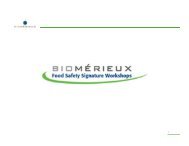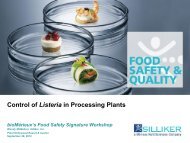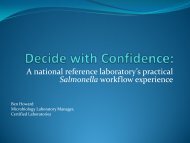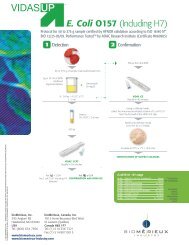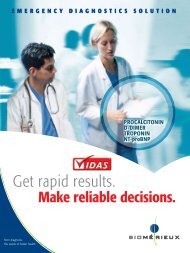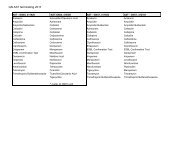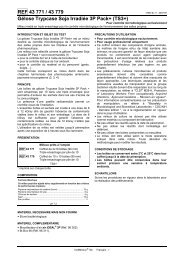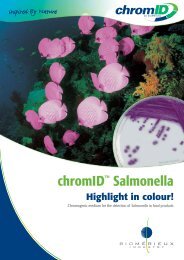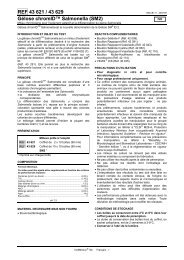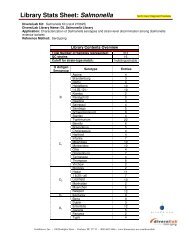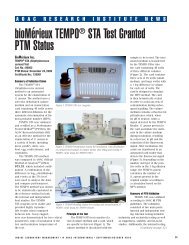EDITORIAL - bioMerieux
EDITORIAL - bioMerieux
EDITORIAL - bioMerieux
Create successful ePaper yourself
Turn your PDF publications into a flip-book with our unique Google optimized e-Paper software.
JANUARY 2011<strong>EDITORIAL</strong>The rise of the NDM-1 superbug, which continues to make headlinesworldwide, should serve as a reminder of the essential role microbiologistsplay in the healthcare value chain. This role becomes all the more importantto clinicians as they are faced with the growing difficulty of treating healthcareassociated infections from multidrug resistant bacteria.Our field is fast-moving and increasingly challenging. New technologies(mass spectometry and maybe someday sequencing) and new trends(increased automation needs) are bringing challenges but also opportunitiesto improve patient care. It is important for microbiologists to stay connectedand stay informed.It is therefore with great pleasure that I welcome you to the first editionof One Microbiology World, bioMérieux’s e-newsletter by and formicrobiologists.As the world leader in microbiology, bioMérieux understands the challengesmicrobiologists are facing. With a legacy of over 45 years, our companyhas been at the leading edge of advances in the field: API ® strips, chromIDchromogenic media, the fastest automated ID/AST system, VITEK ® , Etest ® ,BacT/Alert ® blood culture platform with plastic bottles, DiversiLab ® ,the automation of manual tasks with PREVI Isola and PREVI ColorGram and, for the first time, the integration of VITEK antibiotic susceptibilitytesting and mass spectrometry for microbial identification. Throughout theyears, our objective has been to work side by side with microbiologiststo make microbiology simpler and faster. Today we are doing this in two ways:• developing Full Microbiology Lab Automation solutions to free labtechnicians’ time from repetitive, manual tasks so they can make full useof their expertise,• reducing the time to results so physicians can get their patients on theright treatment faster.We designed this newsletter to offer you a concise, easy-to-manage way tokeep up with recent developments in our field. We want it to be interactiveand a catalyst for exchange between labs. Fellow microbiologists fromaround the world will share their experience with you. We will also bringyou the latest news, including articles on current research, as well as usefulinformation on day-to-day laboratory practices.In this first edition of One Microbiology World, Ms. Linda Bruno,Associate Administrative Director of the University of Illinois MedicalCenter’s laboratory in the U.S., discusses her strategies for screeningmultidrug resistant organisms. Prof. Patrice Nordmann also providesus with insight into the spread of the New Delhi metallo-beta-lactamase 1.Prof. Nordmann heads France’s INSERM Research Unit for“Emerging Resistance to Antibiotics” and is leading one of the firstteams in the world to work on NDM-1 producing bacteria. As heshares what he has observed in his research, Prof. Nordmannstresses the crucial role of microbiological diagnosis for rapidlyidentifying potential NDM-1 carriers and initiating thepreventive measures needed to stem its spread.We would be very interested in receiving your feedbackon the issues raised by One Microbiology World andyour suggestions for future editions.I look forward to a long and stimulating exchange!Thierry Bernard,bioMérieux Corporate Vice President,Global Commercial OperationsIn this issue: > MDRO Screening > NDM-1 > Mass Spectrometry > VITEK ® 2 > chromID > LyfoCults PlusNDM-1Prof. Nordmann, world expert on microbial resistance,gives insight on NDM-1 spreadProfessor Patrice Nordmann, one of the world’s foremost experts on microbial resistancespoke to us about the threat posed by New Delhi metallo-beta-lactamase 1. Prof. Nordmannis chief of the Department of Microbiology at the Bicêtre Hospital, South-Paris Medical School,and head of the INSERM Research Unit U914 (Emerging Resistances to Antibiotics).At the Interscience Conference on Antimicrobial Agents and Chemotherapy (ICAAC) held inSeptember in Boston, Prof. Nordmann chaired a discussion on the appearance of the NDM-1bacterial resistance: why the identification of NDM-1 carriers is more important than that ofother forms of antibiotic resistance in past years, how to detect it in clinical settings and theurgent necessity to take global action. With NDM-1 conferring resistance to the carbapenems- “last resort” antibiotics used to treat Enterobacteriaceae which are already multiresistant (see box)- this is a serious concern to the medical community, says Prof. Nordmann. Furthermore, theNDM-1 gene has been identified in several different bacterial species, indicating a high rateof gene exchange and raising the very real possibility of the spread of superbugs resistant toall or nearly all antibiotics. ••• (page 2)“Anything evolving at such a high rate is going to be very hard to control”Direct from the BenchLinda Bruno is the Associate Administrative Directorof the laboratory at the University of IllinoisMedical Center in Chicago.This is a 350-bed tertiary care hospital.Strategies for ScreeningMultidrug Resistant OrganismsLinda Bruno also manages the microbiology,molecular pathology, and tissue typing laboratories.In addition to the medical center, the laboratoryservices an outreach reference lab, receivingspecimens not only from Illinois but also fromother states. ••• (page 2)
Direct from the Bench••• What strategies have you establishedfor MRSA screenings?The State of Illinois mandates MRSA screening minimally for high-riskpatients. However, it is up to each hospital to decide whether all patientsshould be screened or just high-risk patients. Our hospital only screenspatients being admitted to high-risk nursing units like intensive care, cardiaccare, and newborn wards.How do you screen for MRSA?Altough we are prepared to do either a molecular or cultural method,we use a culture based method; chromogenic media with a 24 hourturn-around-time. The decision was made by the “higher powers that be”justifying it as the most affordable method rather than by a molecularplatform. Turn-around-time was not a driving force.What about other resistant organisms?What is your policy if a patient is admittedand suspected of being a carrier of resistantorganisms like ESBL or KPC?Are they screened?Our hospital does not routinely screen patients for ESBLs or KPCs.We detect these resistant mechanisms along with plasmid AmpC, and morerecently metallo-beta-lactamses in specimens submitted for clinicaldiagnosis. We perform susceptibility testing with VITEK ® 2 and then,depending on the organism and the resistance profiles provided byVITEK 2, we do off-line testing with a 10-disk method, modified Hodge testand/or Etest.We see a good number of ESBLs and KPCs. Typically, KPCs are verycommon in nursing home patients and when detected patients are placedin isolation. If there is an increase in the number of KPCs being detected theInfection Control practitioner may decide to screen other patients for KPCs.The third lesson would be when you get an unusual resistancepattern, you need to question it. When you see something out of theordinary, you need to ask why you are getting this pattern with a pureculture.Has screening had an impacton the incidence of MRSAs?There are at least two hospitals in Illinois that screen all patients.Both institutions have shown that screening all patients has decreased theincidence of MRSA in their institutions. The short-sightedness of all theother hospitals that have not implemented this is they are focusing on theexpense of screening rather than focusing on what would be saved if thenosocomial infection rate would be decreased. The bigger picture shouldbe the focus.Linda Bruno,Associate Administrative DirectorUniversity Medical Center Laboratory Chicago, IllinoisNDM-1What lessons have you learned that you thinkwould benefit other laboratories?First, people who work in microbiology labs must keep up, read articles,attend meetings, talk with colleagues to be aware of what's out there andwhat may be coming. It is imperative that labs be constantly on the alert forthe emergence of new resistance mechanisms and new detectiontechniques. Multiple drug resistant organisms (MDROs) continue to be agrowing problem. Now, we are looking for the New Delhi metallo-betalactamase(NDM1) strain. And there will be more strains in the future.In our lab we are always learning, implementing and looking for new things.Secondly, don't rely 100% on whatever automated system you're using.Be ready to challenge the instrument results taking into account thebug/drug profiles and patient clinical information.Susceptibility testing is so much more hands-on today than it was back inthe ‘70s or ‘80s. The expert software placed in automated systems is veryuseful. However, you still need good, experienced technologists tointerpret the results.NDM-1, New Delhi metallo-ß-lactamase, is an enzyme which has beendetected in various Enterobacteriaceae, notably Escherichia coli andKlebsiella pneumoniae, and other Gram negative bacteria. NDM-1inactivates all members of the ß-lactam class of antibiotics, including thecarbapenems, with the exception of aztreonam, inducing bacterialresistance to the carbapenem antibiotics.••• The Indian ReservoirNDM-1 is prevalent in India, Pakistan and Bangladesh, and not justin hospitals but in the wider community. The presence of the NDM-1 “reservoir”in the Indian subcontinent – where community level infection is high - is a majorfactor contributing to its spread; it is fueled by widespread use of over-the-counterantibiotics, an overcrowded population, and endemic diarrhea in a tropicalclimate with poor hygiene. The chances of reducing this reservoir are almostnegligible. “The true extent of the problem is unclear. While we don’t know at
01/2011 - bioMérieux, the blue logo, VITEK, PREVI, FMLA, VILINK and MYLA are used, pending and/or registered trademarks, belonging to bioMérieux S.A. or one of its subsidiaries / Any other trademark is the property of its respective owner. Product availability may vary fromcountry to country and is subject to varying regulatory requirements / Please contact your local representative for availability / Legal notices - Photos: C. GANET, Graphic Obsession, Panète Bleue / bioMérieux S.A. RCS Lyon 673 620 399 / THERA Conseil RCS Lyon B 398 160 242VITEK ® 2 and Etest ®A Synergistic ApproachAs microbial resistance to antibiotics poses an everincreasingcause for concern, the challenge of detectingresistance and providing clinicians with accurateinformation has grown. VITEK 2, which functions as alaboratory’s primary test system, is capable of detectingresistance and providing same-day identification andsusceptibility testing for the vast majority of organismsencountered in routine clinical laboratories. To provideadditional information needed for treatment decisions,or to complete testing not performed by VITEK 2,Etest, an agar gradient method, synergisticallycomplements VITEK 2 by providing susceptibilitytesting of slow-growing or fastidious organisms that aredifficult to test. Etest provides an extended range ofminimum inhibitory concentrations to provide furtherinformation to clinicians when needed.AST Menu Expansion ProvidesNew VITEK 2 ApplicationsWith the release of VITEK 2 systems software update5.01, bioMérieux has added new susceptibility testingcapabilities to the AST menu. In the past, susceptibilitytesting of pathogens like yeast and viridans streptococciwas not considered a priority. But today, it has becomemore important to provide clinicians with informationregarding resistance in these organisms as well sincethese organisms pose a real health risk in some patientpopulations. In fact, yeast susceptibility testing hasalways been very labor intensive and costly so fewrequests were made of laboratories to perform thistesting. Now, with VITEK 2 automated testing of theseorganism groups, laboratories can provide a rapidresult to clinicians. In response to this increasingdemand for antifungal and Streptococcus susceptibilitytesting, bioMérieux has added AST testing capability tothe fully automated VITEK 2 system. New antifungalshave been added (check with your local bioMérieuxrepresentative for more information on availability),and Streptococcus viridans and Group A Streptococcussusceptibility testing will soon be available.New Remote Access Featureswith VILINK ®and VITEK 2 SystemsSoftware Update 5.01VILINK provides a new range of services for themonitoring and optimization of diagnostic devices, andenables the download of software updates over theInternet. VILINK has been designed to be modular andfirewall friendly so that it is compatible with securityrules put in place by the laboratory or hospital. Based ona standard product developed by Axeda, a leader in thefield of secured Internet based access to diagnosticDirect access to Home Page:www.biomerieux-diagnostics.com©2010 bioMérieux S.A. All rights reserved.bioMérieux S.A. 69280 Marcy l’Étoile - Francesystems, it is designed to ensure secure access. For themicrobiologist, VILINK ensures greater productivityas some routine preventive maintenance and troubleshootingcan be accomplished over the Internet (thusoptimizing “up time”). And, because VILINK enables thelaboratory to quickly download software updates, newsusceptibility test knowledge bases can be downloadedto the VITEK 2 system as soon as they become available.The VITEK 2 systems software update 5.01, coupledwith VILINK also enables remote multi-user access tothe VITEK software application. VITEK results can nowbe brought to the microbiologist’s workbench andVITEK 2 results can be available at the terminals on thelaboratory’s mainframe computer. Multi-user accessmakes it possible for several users to access theVITEK 2 system applications at the same time from theirworkbench. If remote access to the hospital network ispermitted, users can consult the VITEK 2 from anyremote location, even from home.LyfoCults ® Plusa Unique Way to DeliverATCC ® Quality Control StrainsIn light of growing regulatory requirements and to helplaboratories meet quality control demands in ID andsusceptibility testing, bioMérieux has introduced a new,patented all-in-one quality control solution that providesATCC (American Type Culture Collection) licensedderivative quality control strains. Packaged in a selfcontaineddisposable vial, this new glass-free systemensures greater safety and boosts efficiency by eliminatingthe need for additional tools for culturing QC organisms.Immediate hydration without pre-incubation saves time,and the built-in inoculation wandprovides a streaking method thatfacilitates QC plate preparation.Simply crush the vial containingthe diluent thereby rehydrating thelyophilized organism and transferit to an agar plate with the suppliedapplicator. A variety of ATCCmicroorganisms are available inpre-packaged sets providing thecorrect QC strains foruse with commercialsystems like VITEK 2(each strain is provided in two vials). While Lyfocultsproducts have been in use in North America, a new lineof Lyfocults Plus QC sets was recently launchedglobally.Boosted Performance ofbioMérieux’s chromID RangebioMérieux, in its commitment to fight healthcareassociatedinfections, is continuously working toimprove its chromogenic culture media. To facilitate amore rapid identification and treatment of resistantand increasingly problematic pathogens, severalenhancements have been made to bioMérieux'schromID range.chromID MRSA:Now, definitive results are availablewithin 18-24 hours.chromID VRE:The new VRE plates feature heightenedsensitivity, most notably in detectingvanB strains and strains with lowlevel resistance (MIC < 8 mg/l).The enhanced plates also ensureheightened sensitivity at 24 hours.chromID CPS:Provides for the isolation, enumerationand direct identification of majorurinary pathogens. In one singlestep it offers the direct identificationof more E. coli strains, without theneed of indole tests; specificity forgram negative pathogens, especiallyCitrobacter; and the presumptiveidentification of S. saprophyticus.All chromID test results are fully compatible withID/AST reagents and PREVI Isola.



